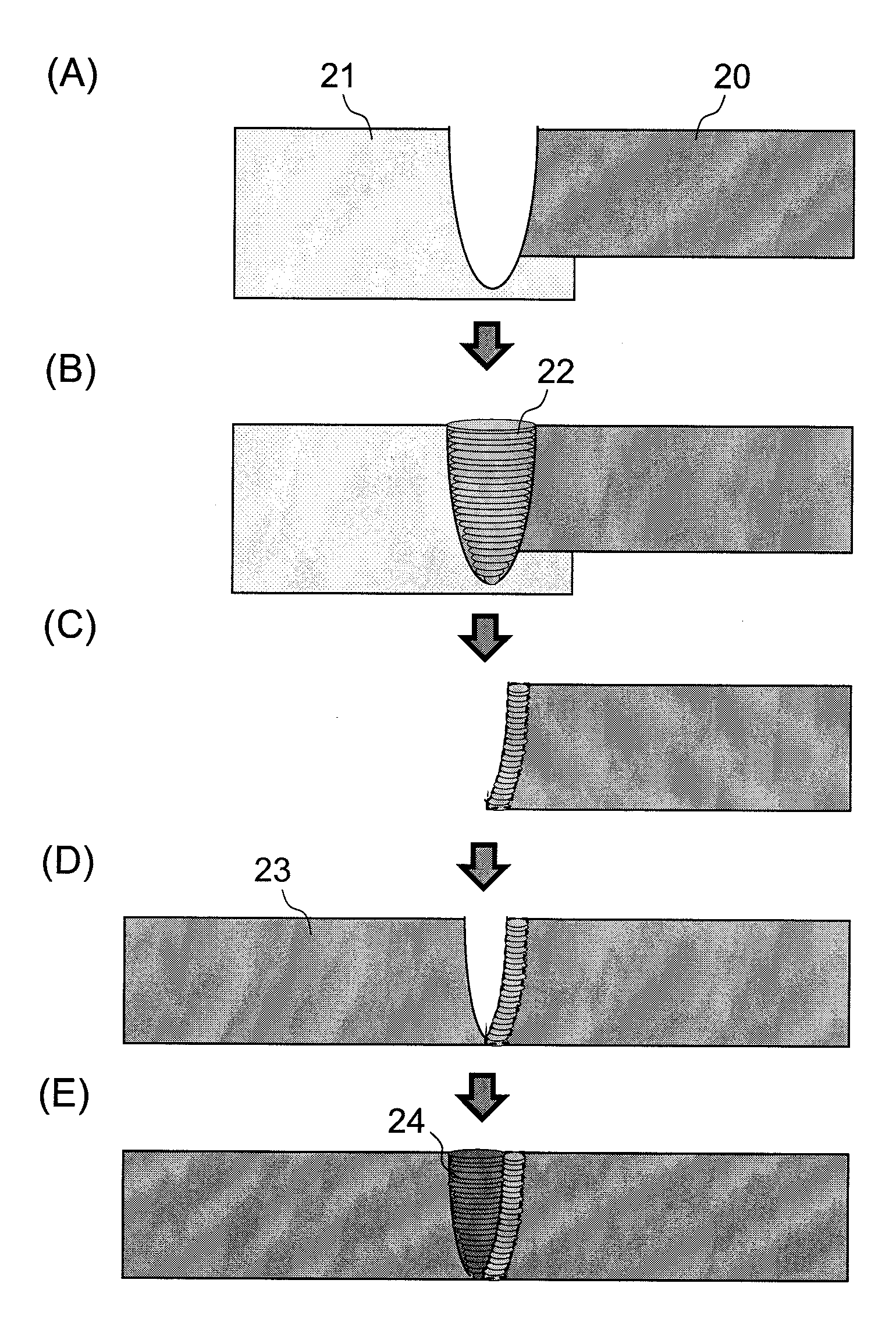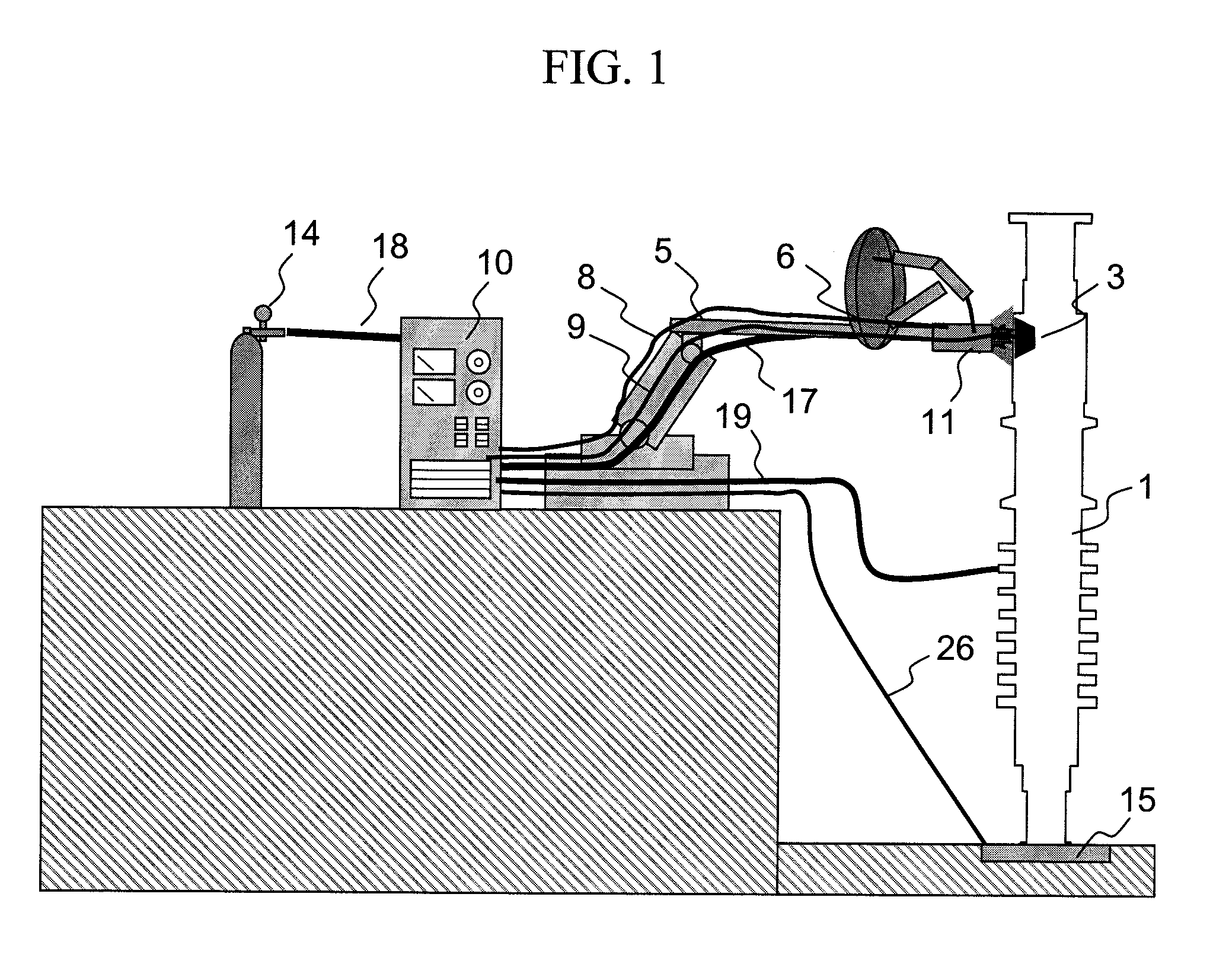Dissimilar metal welds and its manufacturing method of large welded structures such as the turbine rotor
a technology of dissimilar metal welds and manufacturing methods, which is applied in the direction of non-electric welding apparatus, machines/engines, fastening means, etc., can solve the problems of deterioration in strength reliability, difficulty in obtaining characteristics that satisfy, and inability to alleviate the uneven strength caused by heat treatment. , to achieve the effect of improving strength reliability and preventing the deterioration of welding metal strength
- Summary
- Abstract
- Description
- Claims
- Application Information
AI Technical Summary
Benefits of technology
Problems solved by technology
Method used
Image
Examples
example 1
[0026]Example 1 of the present invention will be described below with reference to FIGS. 1 to 6. Though Example 1 illustrates dismissal metal welds of a turbine rotor as dissimilar metal welds, dissimilar metal welds of other product may also be used. The specifications and composition ranges of two dissimilar metals forming the welds are shown in the following Table 1. Example 1 uses an Ni-base superalloy and 12%-Cr steel from Table 1, and these components constitute the dissimilar metal welds.
TABLE 1Kinds of steelsCMnNiCrMoWNbCoBNi-base superalloy0.05~0.20bal. 13~15.50.1~2.04.5~10 0.1~1.05~150.001~0.03Ni—Fe-base≦0.05bal.14~161.9~2.7superalloy12% Cr steel0.1~0.20.3~1.0≦1 9~130.1~1.50.2~5.00.02~0.1 ≦31% Cr—Mo—V steel 0.25~0..350.5~1 ≦10.8~1.51.0~1.53~4% Ni—Cr—Mo—V-0.17~0.320.2~0.43~41.25~2.0 0.25~0.60based steelKinds of steelsVTiAlTaHfZrFeNi-base superalloy0.1~2.04.0~5.50.1~3.00.1~2.00.01~0.1Ni—Fe-base1.2~1.71.1~1.530~40superalloy12% Cr steelbal.1% Cr—Mo—V steel0.2~0.3bal.3~4% Ni—Cr...
example 2
[0046]Example 2 according to the present invention will be described with reference to FIG. 8, (A) to (E). Example 1 has characteristics involving the shape on the bottom side of the weld in the manufacturing method of the dissimilar metal welds, whereas Example 2 has characteristics involving the bottom side as well as the opening side of the weld in the manufacturing method of the dissimilar metal welds. The description of the characteristics identical with those of the Example 1 is herein omitted and only the differences from Example 1 will be described below.
[0047]FIG. 8, (A) to (E), shows a manufacturing flow of welding two members made of different materials according to Example 2. Example 2 differs from Example 1 only in FIGS. 8, (A) and (B). FIG. 8 (A) shows the state of the step of butting the parent material 20 and the dummy material 21. In the vicinity of the opening of each of the parent material 20 and the dummy material 21, a shielding plate 25 is mounted to increase t...
example 3
[0049]Example 3 according to the present invention will be described with reference to FIG. 9, (A) to (E). An Ni-base superalloy and 1%-Cr—Mo—V-based steel are used as two dissimilar metals in Example 3. Example 2 relates to the shape on the bottom side of the weld in the manufacturing method of the dissimilar metal welds, whereas Example 3 relates to the material on the bottom side. The description of the characteristics identical with those of the Example 2 is omitted, and only the differences from Example 2 will be described below.
[0050]FIG. 9, (A) to (E), shows a manufacturing flow of welding two members made of different materials according to Example 3. Example 3 differs from Example 2 only in FIGS. 9 (A) and (B). FIG. 9 (A) shows the step of butting the parent material 20 and the dummy material 21. In the vicinity of the weld bottom, the dummy material 21 and the parent material 20 have the same plate thickness. At a position apart from the vicinity thereof, the dummy materia...
PUM
| Property | Measurement | Unit |
|---|---|---|
| thickness | aaaaa | aaaaa |
| length | aaaaa | aaaaa |
| plate thickness | aaaaa | aaaaa |
Abstract
Description
Claims
Application Information
 Login to View More
Login to View More - R&D
- Intellectual Property
- Life Sciences
- Materials
- Tech Scout
- Unparalleled Data Quality
- Higher Quality Content
- 60% Fewer Hallucinations
Browse by: Latest US Patents, China's latest patents, Technical Efficacy Thesaurus, Application Domain, Technology Topic, Popular Technical Reports.
© 2025 PatSnap. All rights reserved.Legal|Privacy policy|Modern Slavery Act Transparency Statement|Sitemap|About US| Contact US: help@patsnap.com



